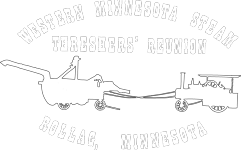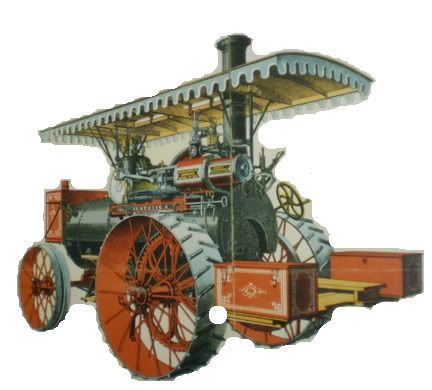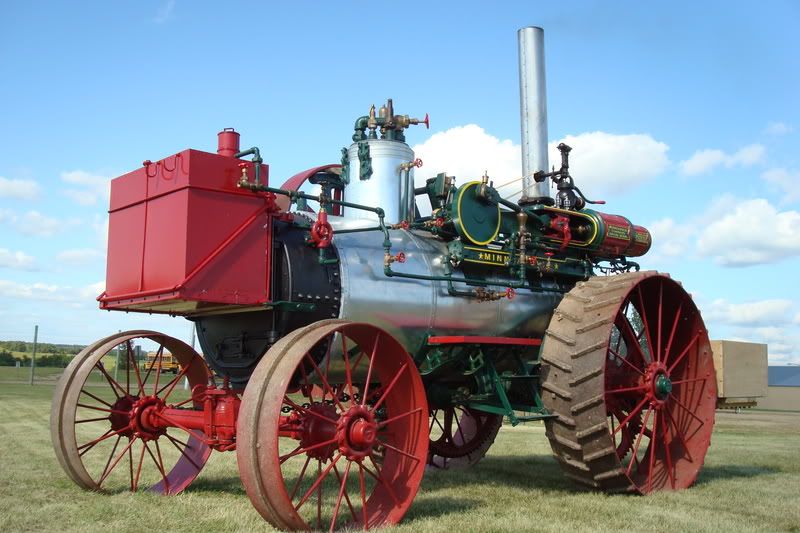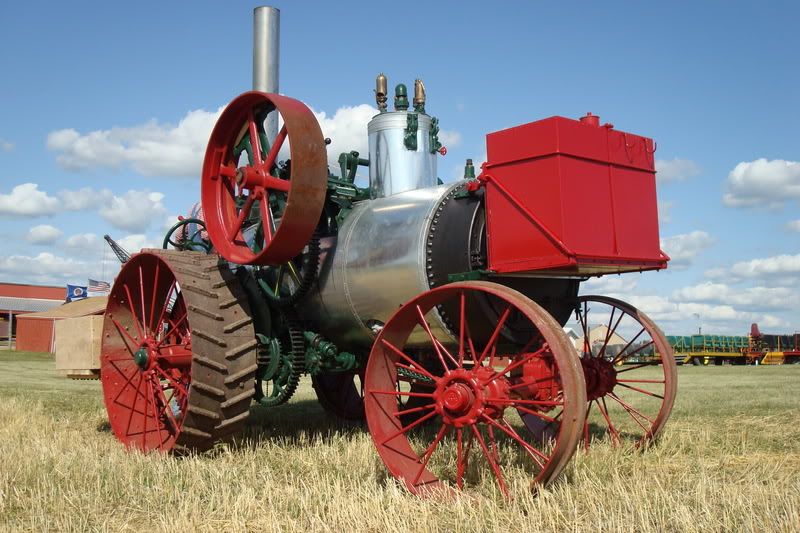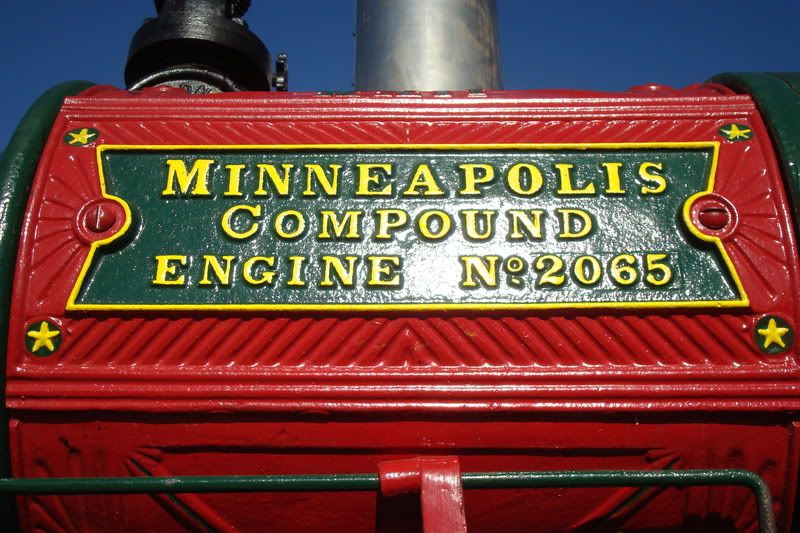You are using an out of date browser. It may not display this or other websites correctly.
You should upgrade or use an alternative browser.
You should upgrade or use an alternative browser.
22HP Minneapolis Return Flue Restoration
- Thread starter ICLIDA
- Start date
After the sun had set we got off the peg.

When we got to about 50 psi we checked the injector and the crosshead pump. They both worked and we were able to locate all of the loose connections between the pump and the check valve. Good thing it was Saturday night as we both needed our bath anyway. Then we started to warm up the cylinders.
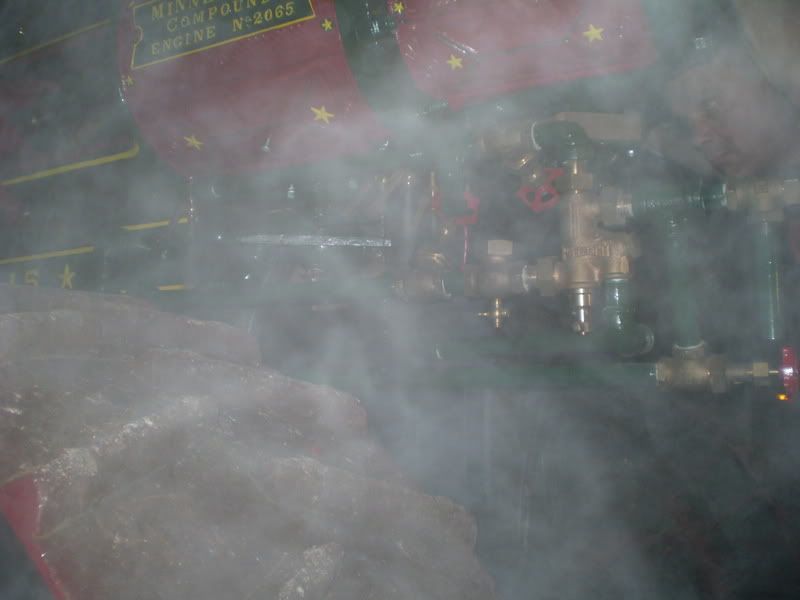
Another shot with less steam.
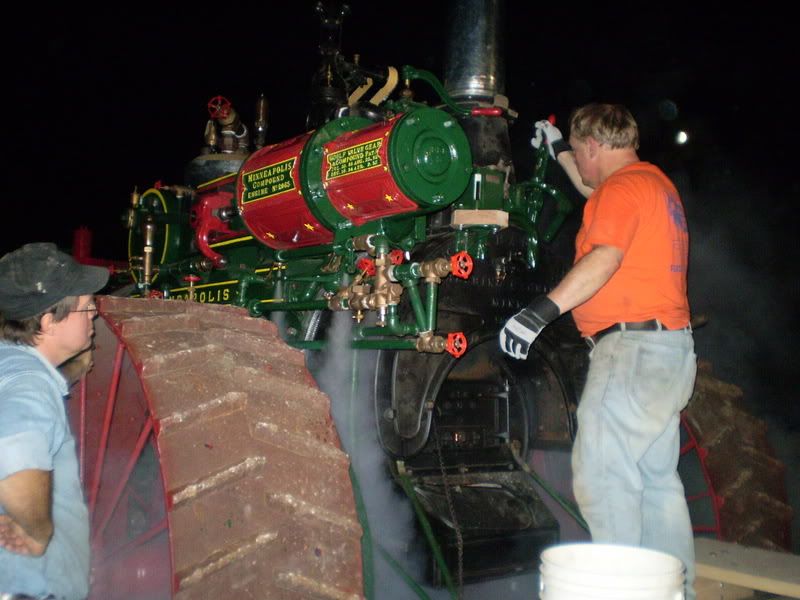
After the cylinders were warmed up we turned it over on steam for the first time. It was a very rewarding moment after all the work that has gone into this restoration. Notice the moon just over Jeff's right shoulder. Isn't there an old song about under the light of the silvery moon.
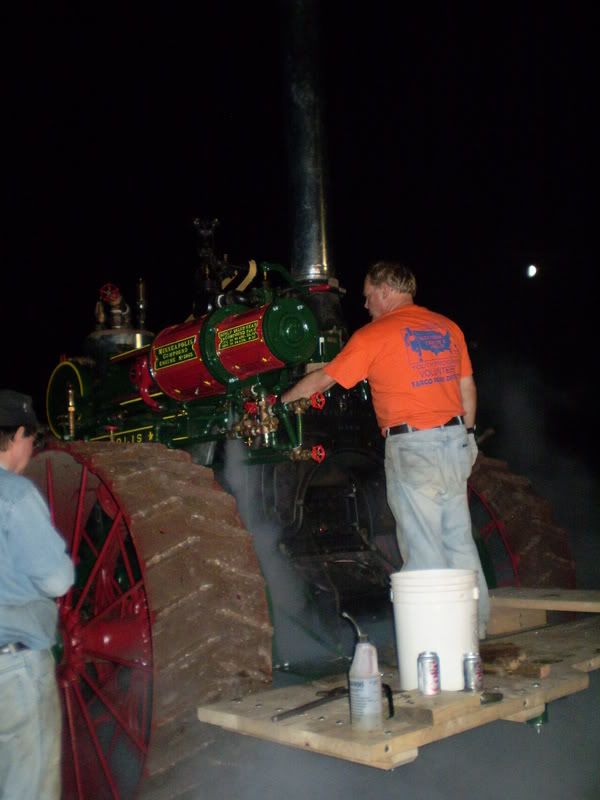
We did try the adjustable exhaust nozzle when the engine was running and you could hear the change in the exhaust as it was adjusted. We won't really know if it makes any difference until we can get a load on the engine and see how it reacts.
There are still some odds and ends to finish up before the show but most of us that have been involved in this restoration will be heading up to Rollag a week early. As soon as we set the campers it's off to Jeff's shop to finish up the last few details and get some hours on the engine before it goes out to the hill.
I understand this engine has a threshing engagement in eastern Minnesota later in September. Jeff, or someone else, may want to expand on that.
Next winter there are plans to add the canopy complete with the original scalloped fringe trimming.

When we got to about 50 psi we checked the injector and the crosshead pump. They both worked and we were able to locate all of the loose connections between the pump and the check valve. Good thing it was Saturday night as we both needed our bath anyway. Then we started to warm up the cylinders.

Another shot with less steam.

After the cylinders were warmed up we turned it over on steam for the first time. It was a very rewarding moment after all the work that has gone into this restoration. Notice the moon just over Jeff's right shoulder. Isn't there an old song about under the light of the silvery moon.

We did try the adjustable exhaust nozzle when the engine was running and you could hear the change in the exhaust as it was adjusted. We won't really know if it makes any difference until we can get a load on the engine and see how it reacts.
There are still some odds and ends to finish up before the show but most of us that have been involved in this restoration will be heading up to Rollag a week early. As soon as we set the campers it's off to Jeff's shop to finish up the last few details and get some hours on the engine before it goes out to the hill.
I understand this engine has a threshing engagement in eastern Minnesota later in September. Jeff, or someone else, may want to expand on that.
Next winter there are plans to add the canopy complete with the original scalloped fringe trimming.
Wow, Looks great. I bet that is a great feeling to have it go under its own steam power. I look forward to seeing it run in person in a couple weeks. Counting the days until showtime
Darren

Darren
Colin
J I Case Steam Enthusiast
Hey- looks good. 
Im sure its been posted earlier but i forget... what is the HP of this engine. and how many were made as compounds, & how many still exist?
what Psi are you going to carry on it.
the big 45 CP has always intrigued me, cant wait to see the next 45 be built.

Im sure its been posted earlier but i forget... what is the HP of this engine. and how many were made as compounds, & how many still exist?
what Psi are you going to carry on it.
the big 45 CP has always intrigued me, cant wait to see the next 45 be built.

Colin,
This is a 1899 22 HP Single Tandem Compound. It has a 7x10x11 engine and was built on the same boiler that had the 18 HP single (8 1/4x11). Jeff and Gerry have the records of how many were made as compounds. Jeff bought 2 engines and the Rynda sale and were both 22 compounds. One of the engines, #2065 started life as a compound, but the other engine #1987 started as a 18 HP single and was rebuilt at the factory in 1903 as a 22 tandem compound and resold as #3710. Both #1987 and #2065 were built in 1899. As far as we know these are the only remaining Minneapolis return flue tandem compound engines left.
The new ASME boiler has a MAWP of 175 psi, but we are going to install a 150 psi safety valve.
As you know I have ran the 45 hp single tandem compound engine at Rollag ever since it was restored in 1987. Jeff's return flue tandem compound has a lot of the same characteristics as the 45 with it's 10 1/4x15x12 engine. It will be fun to see how this compound reacts when we get up around 150 psi on it. The most we have ever run on the 45 is 112 psi and it's a little wet to say the least. Hopefully the 45 will be getting a new boiler in the not too distant future.
If I remember correctly, the peak year for engine production for Minneapolis was in 1904, just 5 years after Jeff's engine was built. We sometimes forget that these older engines did a tremendous amount of work and deserve a special place in agricultural history. We are hoping that this engine along with a wood threshing machine are a good representation of a turn of the century threshing outfit.
As for the 45 double tandem compound (7 1/2x11x10), that restoration will take some time. The 35 single (12x12) will be done first. The 35 single, 45 single tandem compound and the 45 double tandem compound all share the same boiler, with some slight differences. We are getting ahead of ourselves, we need to finish the 22 first.
Tom
This is a 1899 22 HP Single Tandem Compound. It has a 7x10x11 engine and was built on the same boiler that had the 18 HP single (8 1/4x11). Jeff and Gerry have the records of how many were made as compounds. Jeff bought 2 engines and the Rynda sale and were both 22 compounds. One of the engines, #2065 started life as a compound, but the other engine #1987 started as a 18 HP single and was rebuilt at the factory in 1903 as a 22 tandem compound and resold as #3710. Both #1987 and #2065 were built in 1899. As far as we know these are the only remaining Minneapolis return flue tandem compound engines left.
The new ASME boiler has a MAWP of 175 psi, but we are going to install a 150 psi safety valve.
As you know I have ran the 45 hp single tandem compound engine at Rollag ever since it was restored in 1987. Jeff's return flue tandem compound has a lot of the same characteristics as the 45 with it's 10 1/4x15x12 engine. It will be fun to see how this compound reacts when we get up around 150 psi on it. The most we have ever run on the 45 is 112 psi and it's a little wet to say the least. Hopefully the 45 will be getting a new boiler in the not too distant future.
If I remember correctly, the peak year for engine production for Minneapolis was in 1904, just 5 years after Jeff's engine was built. We sometimes forget that these older engines did a tremendous amount of work and deserve a special place in agricultural history. We are hoping that this engine along with a wood threshing machine are a good representation of a turn of the century threshing outfit.
As for the 45 double tandem compound (7 1/2x11x10), that restoration will take some time. The 35 single (12x12) will be done first. The 35 single, 45 single tandem compound and the 45 double tandem compound all share the same boiler, with some slight differences. We are getting ahead of ourselves, we need to finish the 22 first.
Tom
Colin
J I Case Steam Enthusiast
Hi, thanks for the reply. i guess i got so into reading the updates and watching the pictures load i didn't see the HP in the thread title

Ive looked over the 35/45 stuff a bit, they will be quite the projects. sure nice that stuff got saved.
Also would be good to see the old Pross 45 get a new boiler! and be able to carry some more Psi.
Ive looked over the 35/45 stuff a bit, they will be quite the projects. sure nice that stuff got saved.
Also would be good to see the old Pross 45 get a new boiler! and be able to carry some more Psi.

Colin and Tom: I posted this on Smokstak a while back, it concurs with Tom's information above with a few more pieces of production data. See ya fellows at the show in two weeks!!!
Ray
Finally, the RF discussion:
"Not a whole lot to tell on these two, at least from the production record angle.
2065 was manufactured as a 22 HP TC in 1899. By that time they were going to a heavier crank pin! Before 1898 they had used a 1 3/4" crank pin but then went to a 2 1/4" which is what both your (Jeff's) engines have. And both engines have a crankpin length of also 2 1/4" sticking out of the crankdisc.
3710 was dated from 1903 and simply states that it was "changed from 18 HP." There is no reference to what the number was when it was an 18? However, by looking at all the other return flue records there is only one, #1987, an 18 built in 1899 that was compounded in 1903 (also "rebuilt 1908") and I think that is our baby. So these two engines are from the same year (1899) originally and I would assume knew one another at the factory?
I also noticed that 4 return flue engines were equipped with 4" extensions and one, a 27HP compnd had 30" wide drivers. A LOT of simples were converted to compounds in the years from 1898 until into 1906 or so. I think we need to assume that the Minneapolis compound return flue was not a "dog" but that it worked pretty well!
MTM made 4345 RF engines, they made 4190 with firebox boilers, 499 doubles and 3691 singles. There were 192 of the 22 RF TC engines, 53 were coal and 139 were straw burners.
Most of this research was done 20 years ago!
Hope that supplies some info for you to use to document these machines.
Oh but we have lost so much of the Return Flue part of this wonderful heritage! "
Hope you enjoy these Minneapolis Threshing Machine Company facts put together by Dr. Parker. Many of us are blessed on a regular basis with these historical facts, and this seemed like the exact place to include a portion of them!
Later Ray.
Ray
Finally, the RF discussion:
"Not a whole lot to tell on these two, at least from the production record angle.
2065 was manufactured as a 22 HP TC in 1899. By that time they were going to a heavier crank pin! Before 1898 they had used a 1 3/4" crank pin but then went to a 2 1/4" which is what both your (Jeff's) engines have. And both engines have a crankpin length of also 2 1/4" sticking out of the crankdisc.
3710 was dated from 1903 and simply states that it was "changed from 18 HP." There is no reference to what the number was when it was an 18? However, by looking at all the other return flue records there is only one, #1987, an 18 built in 1899 that was compounded in 1903 (also "rebuilt 1908") and I think that is our baby. So these two engines are from the same year (1899) originally and I would assume knew one another at the factory?
I also noticed that 4 return flue engines were equipped with 4" extensions and one, a 27HP compnd had 30" wide drivers. A LOT of simples were converted to compounds in the years from 1898 until into 1906 or so. I think we need to assume that the Minneapolis compound return flue was not a "dog" but that it worked pretty well!
MTM made 4345 RF engines, they made 4190 with firebox boilers, 499 doubles and 3691 singles. There were 192 of the 22 RF TC engines, 53 were coal and 139 were straw burners.
Most of this research was done 20 years ago!
Hope that supplies some info for you to use to document these machines.
Oh but we have lost so much of the Return Flue part of this wonderful heritage! "
Hope you enjoy these Minneapolis Threshing Machine Company facts put together by Dr. Parker. Many of us are blessed on a regular basis with these historical facts, and this seemed like the exact place to include a portion of them!
Later Ray.
Brad Kelley
Junior Poster
Keep up the good work you guys!! This is one of my favorite restoration threads!!


Brad Kelley;5084 said:Keep up the good work you guys!! This is one of my favorite restoration threads!!

Brad,
I'm glad you have enjoyed this thread. I has been fun documenting this process and I hope it gives people an idea of the amount of time and work that goes into a project like this. I have learned a lot during this process and it has been great spending so much time with others that share a common interest.
Is there any chance that you will be at the show this year to see the end result? If so, be sure to look us up.
I talked to Jeff tonight and he and Gerry are going to fire up again tomorrow afternoon after the other engines get pulled out of the buildings in the morning at the show grounds. I sure wish I could be there, but I have to wait until next weekend to go play again.
I wonder what we should do after the canopy is done? Any suggestions?
Tom
Colin
J I Case Steam Enthusiast
Thanks again Ray and Tom for all the details posts. im planing on being there this year and running a freinds engine again. so ill be able to check her out.
Was wondering what year Jeffs 35 and 45 are? I want to say the current 45 is an 1907? or was there just 7 made? been a little while since i read the sign. how many 35s and DTCP 45s were made? seems funny they didn't call the single TC a 40HP. to designate each model? just a thought.
can't wait to get to the hill

Was wondering what year Jeffs 35 and 45 are? I want to say the current 45 is an 1907? or was there just 7 made? been a little while since i read the sign. how many 35s and DTCP 45s were made? seems funny they didn't call the single TC a 40HP. to designate each model? just a thought.
can't wait to get to the hill


Stopped by Knut's on Saturday and he had steam up on the 22!! My first time seeing it run.........gave me goose bumps!! What a machine. Good job all, I'll see you on the hill in........two...........no ONE week!!!
Ray
Ray
Brad Kelley
Junior Poster
Tom,
I don't have plans to attend Rollag this year, but thanks for the invitation. Hopefully I can come see the show next year.
I have a 18hp Huber waiting for restoration when I finish working the bugs out of my 9hp Case. I'm 90% shure my Huber will need a new boiler, so I'm very excited to see a brand new return flue being built. Although, my boiler will be a little more complicated with Huber's water jacket around the combustion chamber.
I will certainly be seeking advice from everyone involved in this project when I begin designing and shopping for my new boiler.
Thanks!
http://www.smokstak.com/forum/showthread.php?p=214621#post214621


I don't have plans to attend Rollag this year, but thanks for the invitation. Hopefully I can come see the show next year.
I have a 18hp Huber waiting for restoration when I finish working the bugs out of my 9hp Case. I'm 90% shure my Huber will need a new boiler, so I'm very excited to see a brand new return flue being built. Although, my boiler will be a little more complicated with Huber's water jacket around the combustion chamber.
I will certainly be seeking advice from everyone involved in this project when I begin designing and shopping for my new boiler.
Thanks!
http://www.smokstak.com/forum/showthread.php?p=214621#post214621


Colin;5098 said:Thanks again Ray and Tom for all the details posts. im planing on being there this year and running a freinds engine again. so ill be able to check her out.
Was wondering what year Jeffs 35 and 45 are? I want to say the current 45 is an 1907? or was there just 7 made? been a little while since i read the sign. how many 35s and DTCP 45s were made? seems funny they didn't call the single TC a 40HP. to designate each model? just a thought.
can't wait to get to the hill
Colin,
I don't know the exact year of Jeff's 35 and 45, but there were 116 35 singles made between 1905 and 1915. There were only 7 45 STC engines made, all in 1907, 6 of which were traction engines and one skid engine. There were 36 45 DTC engine made between 1908 and 1910. Both the 35 and the 45 DTC engines are double geared engines with the counter shaft that goes through the 5" id tube in the boiler. The 45 STC is a single geared engine and does not have the counter shaft and the tube through the boiler.
It is really interesting to have access to all of these records from Minneapolis so we can try to better understand how things progressed. A big thanks goes to Gerry Parker for supplying all of this information.
See ya on the hill.
Tom
Brad Kelley;5113 said:Tom,
I don't have plans to attend Rollag this year, but thanks for the invitation. Hopefully I can come see the show next year.
I have a 18hp Huber waiting for restoration when I finish working the bugs out of my 9hp Case. I'm 90% sure my Huber will need a new boiler, so I'm very excited to see a brand new return flue being built. Although, my boiler will be a little more complicated with Huber's water jacket around the combustion chamber.
I will certainly be seeking advice from everyone involved in this project when I begin designing and shopping for my new boiler.
Thanks!
http://www.smokstak.com/forum/showthread.php?p=214621#post214621


Brad,
Too bad you can't make it this year, but we will try to get a lot of pictures of the engine in action.
When Jeff got these 2 engines we didn't even put a UT on the boilers. The plan from day one was to go with a new ASME boiler, but to try to make it as original looking as possible. I think we can very close with the fake lap seam and the row of rivets around the front of the boiler.
When Minneapolis started in 1887 they were only manufacturing threshing machines. I don't think they made there first engine until 1893 or 1894. During these early years, Minneapolis sold Huber engines to go along with their threshing machines. When you look at the Minneapolis return flue engines you can really see the influence Huber had on the first engines, as there are a ton of similarities.
I have some idea's on how I would build a new Huber boiler and what I would do around the combustion chamber. If you want, I will be more then happy to share them with you.
4 more days till I go to the "Hill". I can't wait.
Tom
Brad Kelley
Junior Poster
I don't recall reading in the thread what will be done with the second Minnie? Is it complete, or was it parted out to build 1 complete engine?
I've seen pictures of the early Huber and Minnie engines, and from what I've seen the only distinguishing features are the canopy and water jacket on the Huber engines! I really wish my Huber had the artistic features of the Minneapolis. Those castings are beautiful and the paint scheme is just stunning!
Tom, that water jacket on my boiler will be the biggest hurdle in building a new one. If the Code allows and I can have a new piece made I'd like to make it functional. I'd love to hear your ideas, but we'll take that discussion somewhere else.
Thanks!
I've seen pictures of the early Huber and Minnie engines, and from what I've seen the only distinguishing features are the canopy and water jacket on the Huber engines! I really wish my Huber had the artistic features of the Minneapolis. Those castings are beautiful and the paint scheme is just stunning!
Tom, that water jacket on my boiler will be the biggest hurdle in building a new one. If the Code allows and I can have a new piece made I'd like to make it functional. I'd love to hear your ideas, but we'll take that discussion somewhere else.
Thanks!
Brad,
I don't know if there are any final plans for the other engine yet. There has been some talk about cutting the old boiler up for display for steam school, or maybe a big grill for the campground. I think that steam school will win out. There were parts pulled off from both engines to rebuild one, but all of the parts are still there.
I am going up today and if I remember I will get some pictures of the other engine.
I agree that the water jacket will be your biggest hurdle on a Huber. As I said, I do have some ideas for it, but we will take that off line for now.
Jeff and Gerry ran the engine again last Saturday for a few hours. On Saturday we will be at Jeff's finishing up some of the last items and putting some more time on the engine. I made up a perforated baffle that we are going to install in front of the grates which should keep the wood from falling over the front grate support.
Here is another picture from 2 weeks ago.
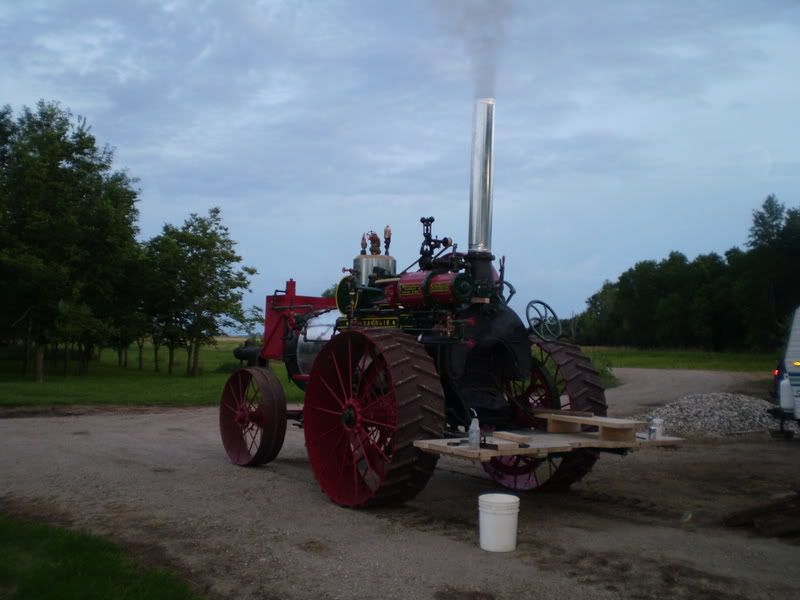
I don't know how much Internet access I will have for the next couple of weeks so I may not be able to post much until after the show.
Tom
I don't know if there are any final plans for the other engine yet. There has been some talk about cutting the old boiler up for display for steam school, or maybe a big grill for the campground. I think that steam school will win out. There were parts pulled off from both engines to rebuild one, but all of the parts are still there.
I am going up today and if I remember I will get some pictures of the other engine.
I agree that the water jacket will be your biggest hurdle on a Huber. As I said, I do have some ideas for it, but we will take that off line for now.
Jeff and Gerry ran the engine again last Saturday for a few hours. On Saturday we will be at Jeff's finishing up some of the last items and putting some more time on the engine. I made up a perforated baffle that we are going to install in front of the grates which should keep the wood from falling over the front grate support.
Here is another picture from 2 weeks ago.

I don't know how much Internet access I will have for the next couple of weeks so I may not be able to post much until after the show.
Tom
Now that we are all rested up from the show, and the mad dash to get Jeff's engine ready for the show, we are getting back to the finishing touches on the engine. We still need to do some painting and pin striping, and build the canopy. The engine run very well during the show and there should not be any more mechanical work needed at this time.
This last weekend we worked on the frame for the canopy. We plan to finish the canopy the week between Christmas and New Year. The engine is scheduled to be at the April MSEA meeting in Fargo. Jeff has also been invited to display the engine at the Pawnee, Oklahoma show the first weekend in May. Plans are underway for about a dozen of us to go along with the engine to the show.
I have some pictures from this last weekend that I will post in a few days. Things have been a little slow on this site, but now that it's winter we should have a little more time to post information.
Tom
This last weekend we worked on the frame for the canopy. We plan to finish the canopy the week between Christmas and New Year. The engine is scheduled to be at the April MSEA meeting in Fargo. Jeff has also been invited to display the engine at the Pawnee, Oklahoma show the first weekend in May. Plans are underway for about a dozen of us to go along with the engine to the show.
I have some pictures from this last weekend that I will post in a few days. Things have been a little slow on this site, but now that it's winter we should have a little more time to post information.
Tom
